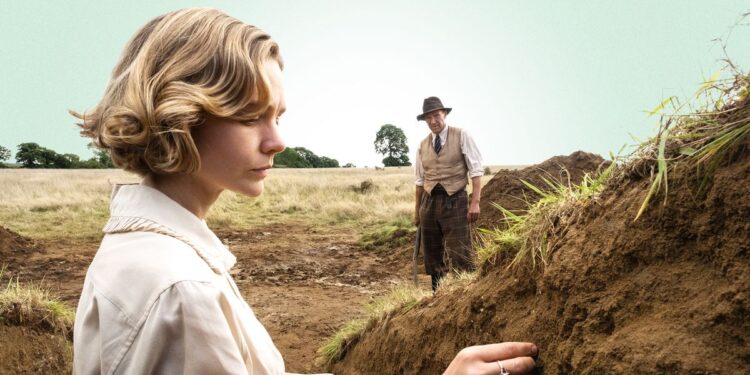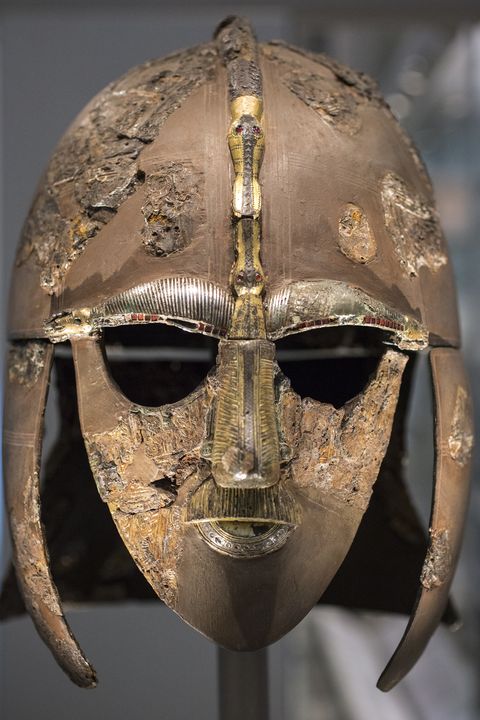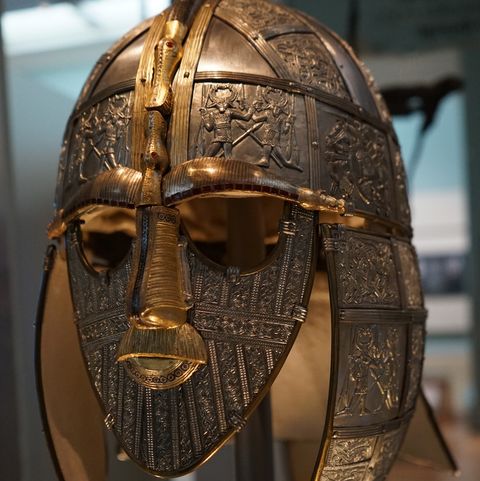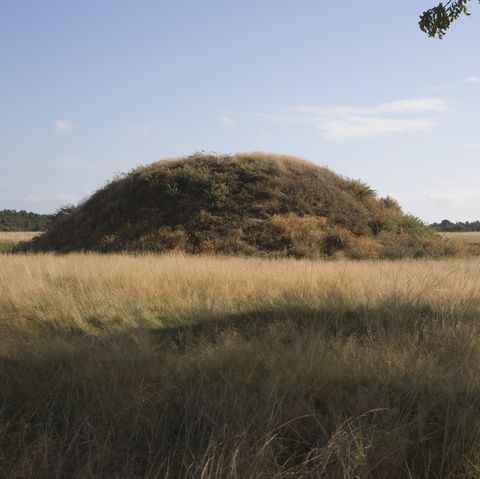Netflix’s The Dig is a quietly lovely drama set in late 1930s England. It’s got everything a fan of British period films could ask for—gently verdant landscapes, gorgeous sweaters, and characters whose preferred means of conducting tough conversations is via loaded glances. But the movie, which stars Carey Mulligan and Ralph Fiennes and is based on a 2007 novel by John Preston, isn’t just a lush and well-reviewed period piece. It may be a fictionalized tale, but it’s based on the true story of one of the U.K.’s most significant archaeological finds, a discovery that reshaped the nation’s understanding of its history. Here’s what you should know.
Cary Mulligan and Ralph Fiennes star as the real-life figures Edith Pretty and Basil Brown.
Pretty was born Edith Dempster in 1883 to a wealthy manufacturing family. After she married Frank Pretty, who, as described in the film, proposed to her 15 times before she said yes, the couple bought the Sutton Hoo estate. The property was located in southeast England and featured 18 mounds of earth that were, according to local legend, ancient burial mounds. The area derived its name from the nearby village of Sutton, while “hoo” is Old English for “spur of land.” After her husband’s death, Pretty, who lived on the estate with her son Robert (played in The Dig by Archie Barnes), became determined to have the mounds excavated. She was put in touch with the local Ipswich Museum, which arranged for Basil Brown, an amateur archaeologist who worked with the institution, to begin excavations.
Brown, played by Fiennes in the film, was an accomplished autodidact. Born to farmers in 1888, he left school at age 12 to work on the farm but taught himself Latin, French, and astronomy. He worked odd jobs, including as a milkman and gardener, while pursuing his less remunerative passions of astronomy and archaeology. By 1938, he’d already written a book about astronomy, and was working as a freelance archaeologist at the Ipswich Museum. When Pretty hired him to begin excavating the mounds on her property, it sparked an archaeological investigation that would continue for decades.
Pretty and Brown realized that they’d made an extraordinary discovery.
The first three mounds that Brown and his assistants explored during the summer of 1838 revealed objects including knives and an axe head, as well as textiles, bronze fragments, and human remains. But many of the mounds had already been raided by grave robbers, and there was no larger hoard.
In 1939, the team at Sutton Hoo decided to tackle the largest mound of all. It too had been explored by vandals, but thankfully, they missed the massive treasure it held: An 80-foot-long burial ship. By that time, it was more like the ghost of a ship—the acidic earth had decayed the wood and the body of whoever was buried there, but the imprint of the hull and its rivets remained pressed into the dirt.
The size of the ship suggested that this might be a significant burial site, and professional archeologists Charles Phillips (played by Ken Stott), Peggy Piggott (Lily James), and her husband Stuart Piggott (Ben Chaplin) were brought in. Peggy Piggott was the aunt of The Dig author John Preston, and her involvement in the excavation is what inspired him to write the book. (The character of Rory Lomax, played by Johnny Flynn, is fictional, as are the film’s romantic subplots.) Brown remained on the project, but was demoted to an assisting role. Though the fictionalized film portrays tensions between Brown and Phillips, according to the National Trust, which now owns Sutton Hoo, the two men had a “respectful relationship,” while the real tensions were between Phillips and the Ipswich museum.
Inside the largest mound the team found remarkable Anglo-Saxon treasures. The ship had likely included a platform onto which the deceased’s body had rested, surrounded by his bounty for the after life. The most famous object recovered is the Sutton Hoo helmet, decorated with precious stones and featuring beautifully ornate metalwork. The body, which was clad in an outfit that featured golden shoulder clasps, was also buried surrounded by silver bowls, spoons, spears, a sword, and even a chess-like board game called Hnefatafl. Google has a handy collection of hi-res images of the Sutton Hoo helmet and other artifacts from the site on its Arts and Culture website.
The extravagance of the burial suggested that a high-status person was interred in the mound. Exactly who was buried there is unknown, many scholars agree that the ship was most likely the grave of Raedwald, the first Christian king of East Anglia, who reigned from around 599 to 624.
Work continued on the site for decades, revealing it to be a rich burial ground.
Pretty was so thrilled with the discovery that she hosted a party on the grounds to celebrate the find. After inviting her guests to “view remains of Viking ship burial,” visitors drank sherry while Phillips gave a speech about the discovery. Few could hear it, as planes from the Royal Air Force were flying overhead. During World War II, the treasure from Sutton Hoo would be hidden underground—this time in a Tube station, for safekeeping.
Brown continued to work as a local archaeologist for decades until his death in 1977. After an inquest declared Pretty the owner of the treasure found on her property, she donated it to the British Museum. In honor of her gift to the nation, then-Prime Minister Winston Churchill offered her the title of Commander of the British Empire, which she turned down. Pretty died in 1942.
Digs have continued at Sutton Hoo into the 21st century, and other major finds included a young man buried with his sword, shield, and horse. There were also human remains that showed evidence of violent deaths, suggesting that Sutton Hoo was the site of executions.
Today, the site is owned by Britain’s National Trust for Places of Historic Interest or Natural Beauty. Sutton Hoo is open to the public (though indoor exhibitions, including those located in the Pretty family’s former home, are closed due to the COVID-19 pandemic).
The discoveries at Sutton Hoo transformed British understanding of the “Dark Ages.”
The Roman retreat from Britain in the 5th century AD began an era that was for centuries known as the “Dark Ages,” and which lasted until the Norman invasion of 1066. During the years in between, England was divided into often-warring kingdoms ruled by Anglo-Saxon tribes from northern Europe. It’s to this era that the English language dates. But future generations found few traces of Anglo-Saxon culture (including, notably, the epic poem Beowulf.) This gap in available knowledge gave the “Dark Ages” its derisive nickname, as it was assumed that the Anglo-Saxons produced few valuable cultural artifacts. But the discoveries at Sutton Hoo helped lead to a different perspective of the era. Objects found buried had origins that ranged from Sri Lanka to Istanbul, and painted a portrait of elaborate traditions, skilled craftsmanship, and rich cultural exchanges.
Join Esquire Select
This content is created and maintained by a third party, and imported onto this page to help users provide their email addresses. You may be able to find more information about this and similar content at piano.io










